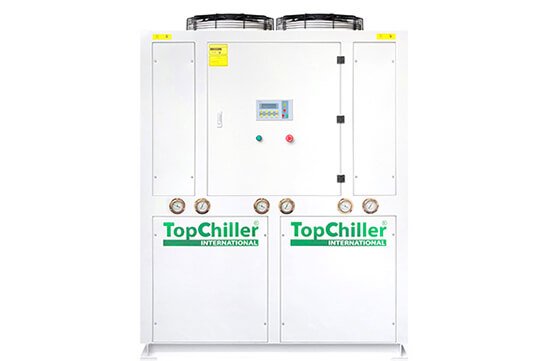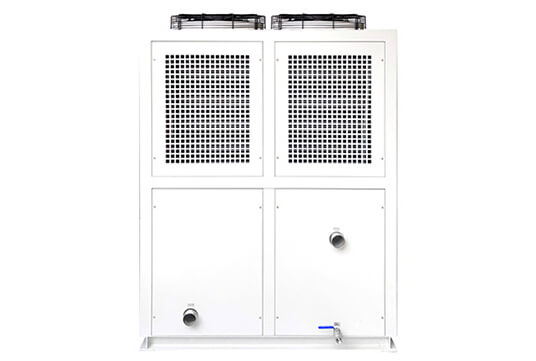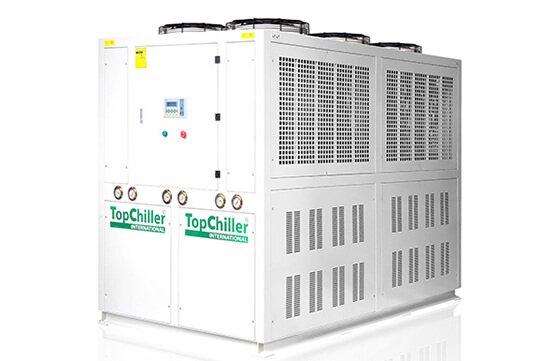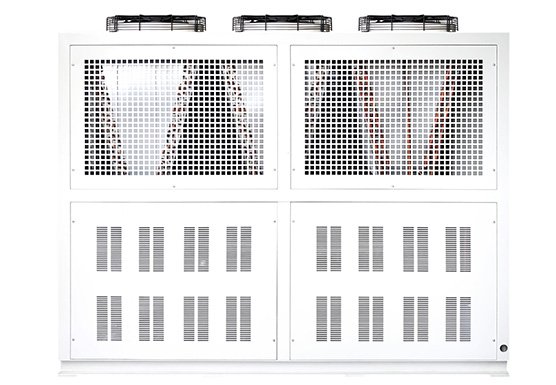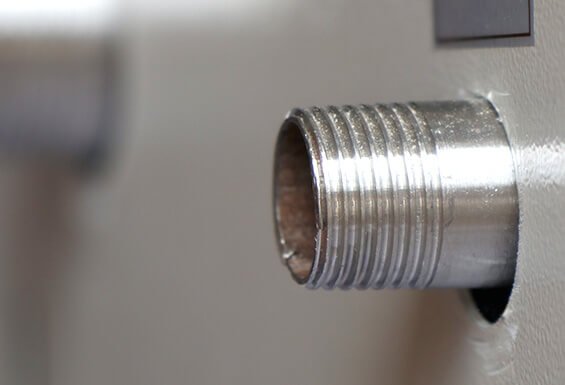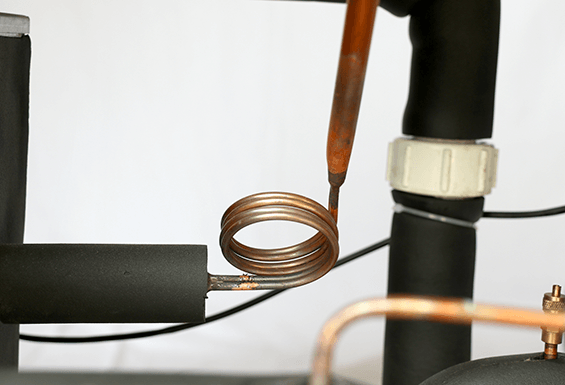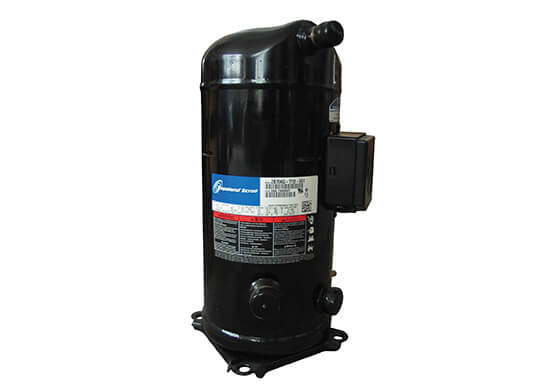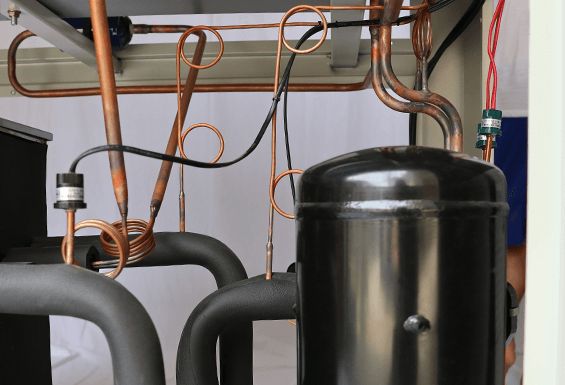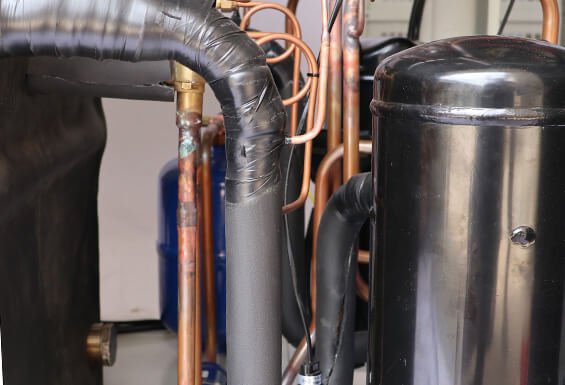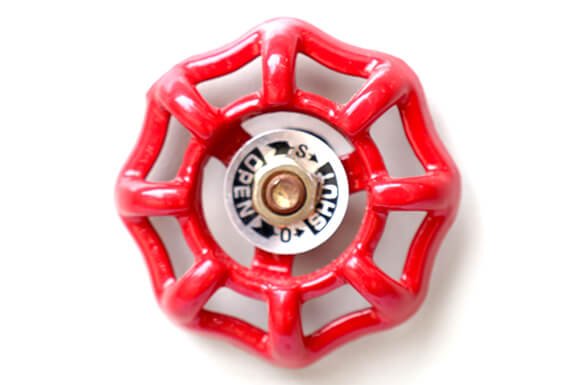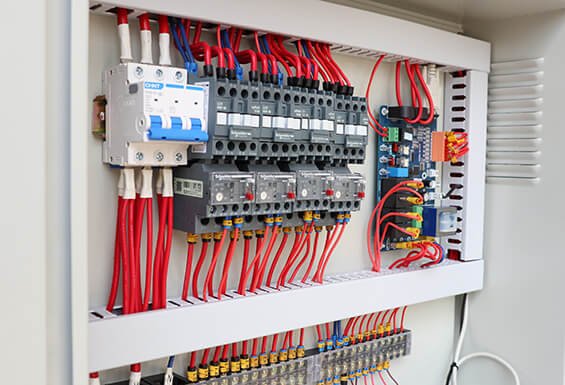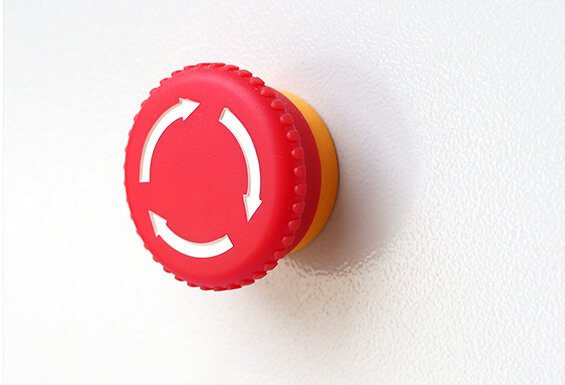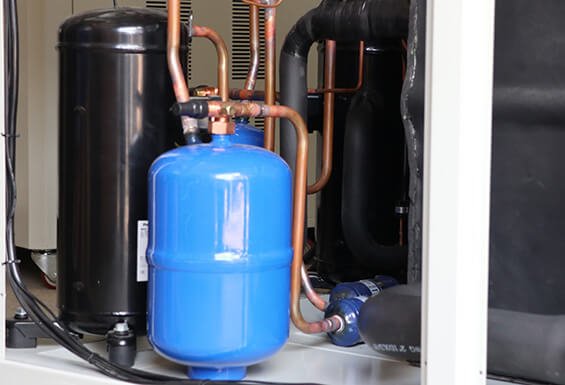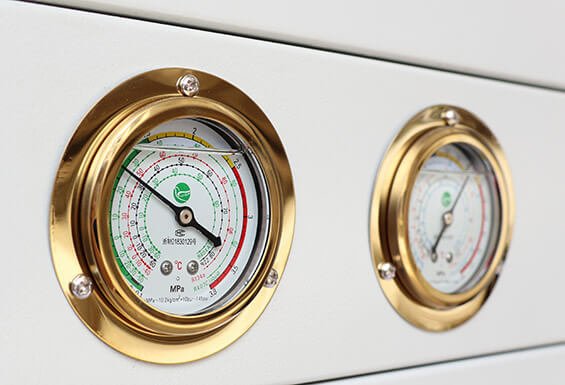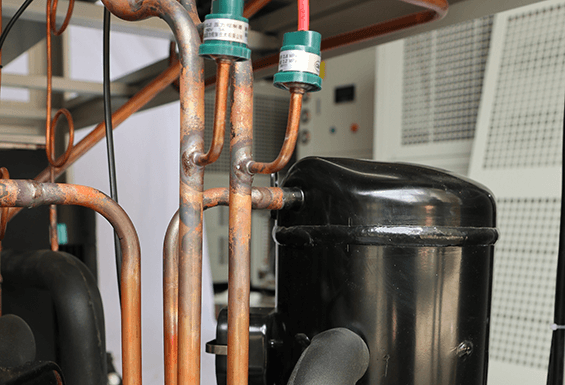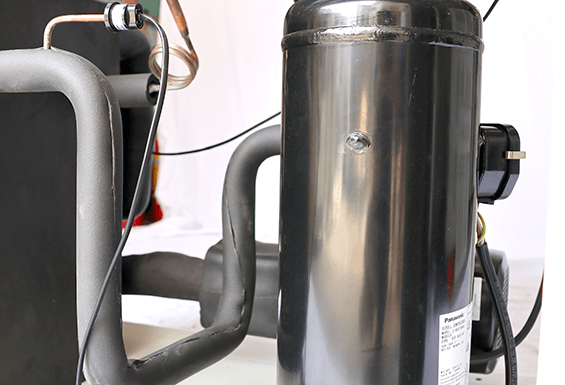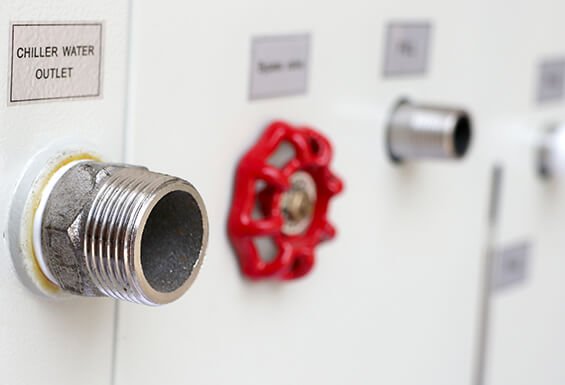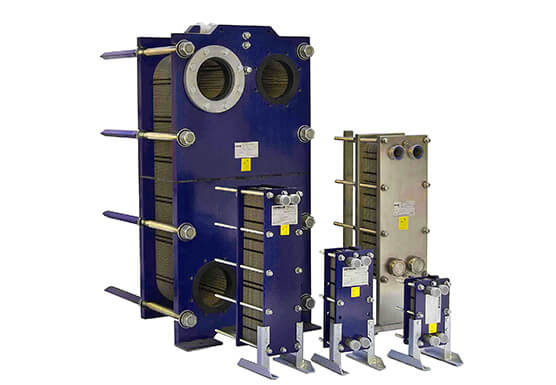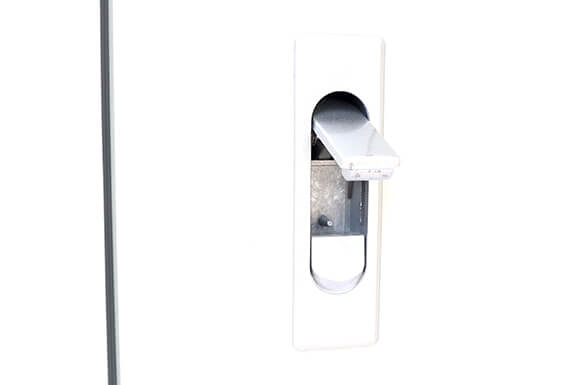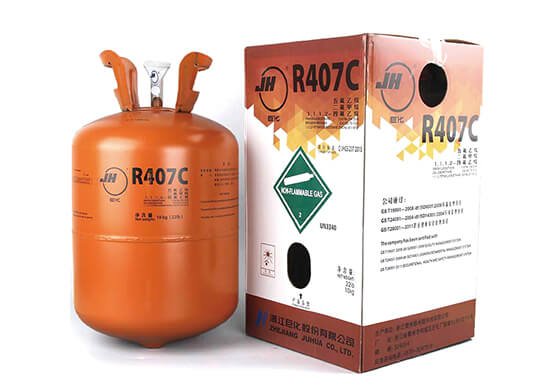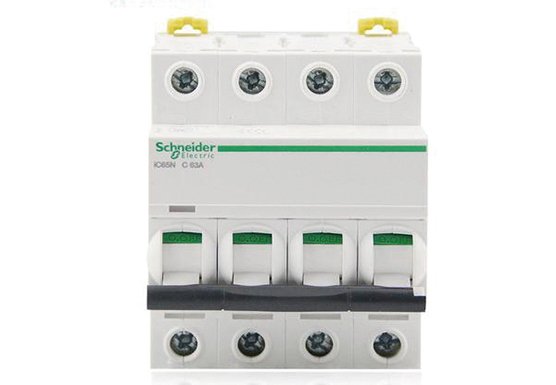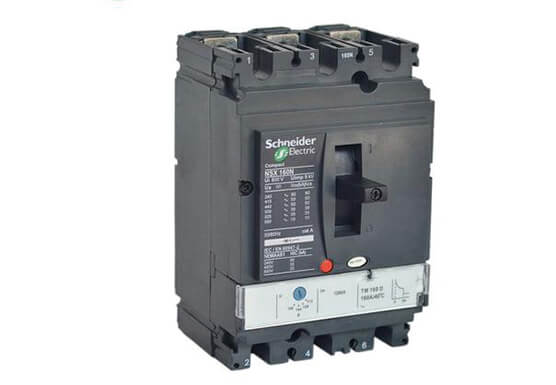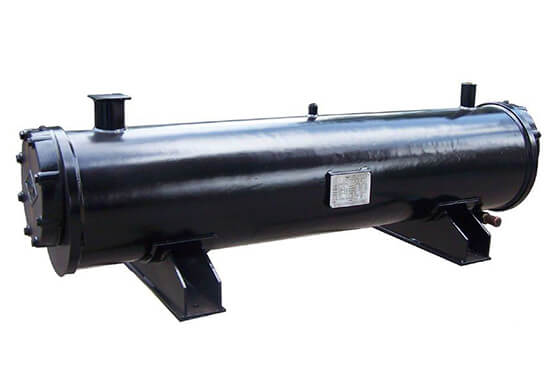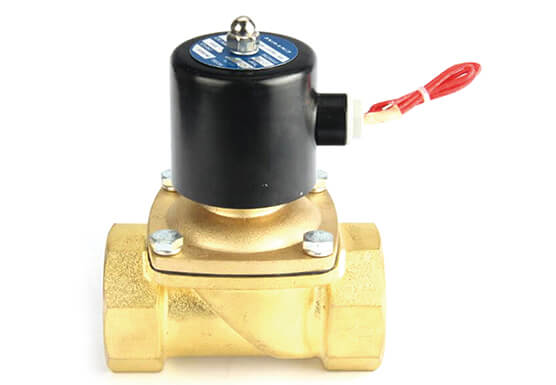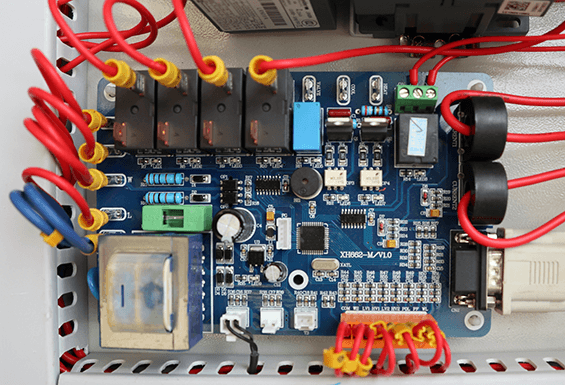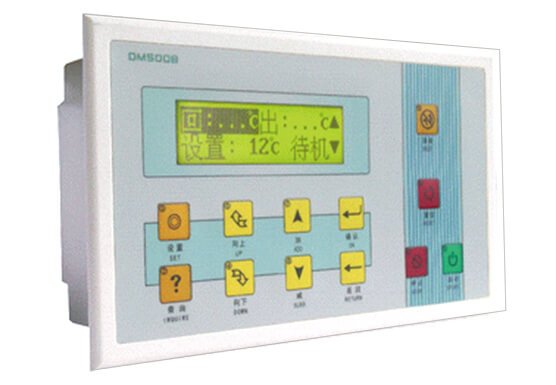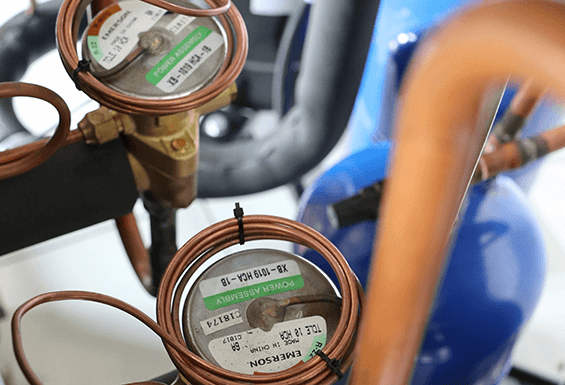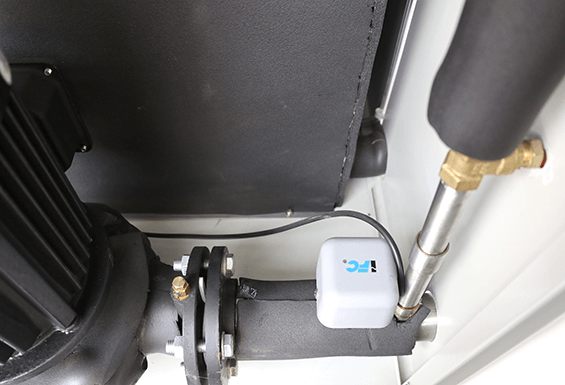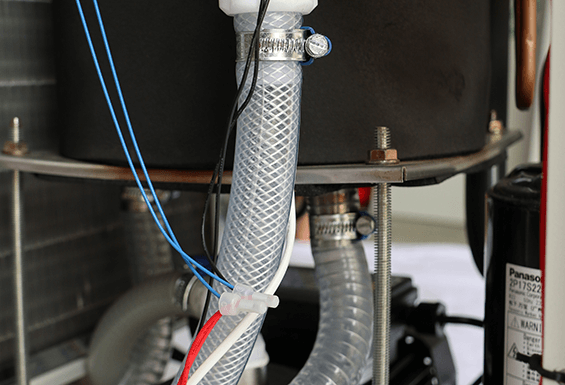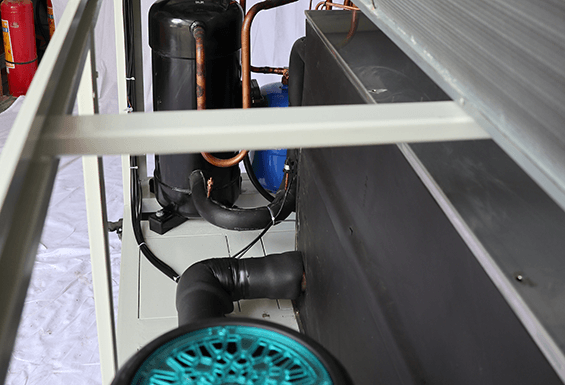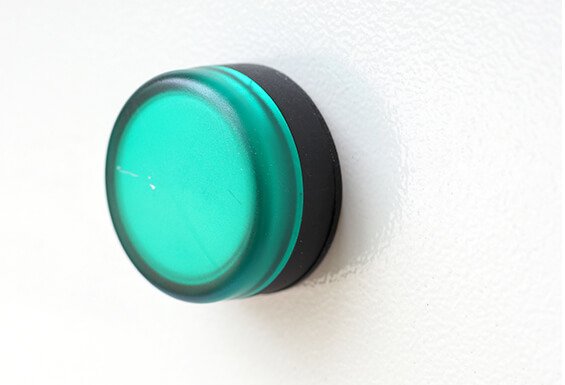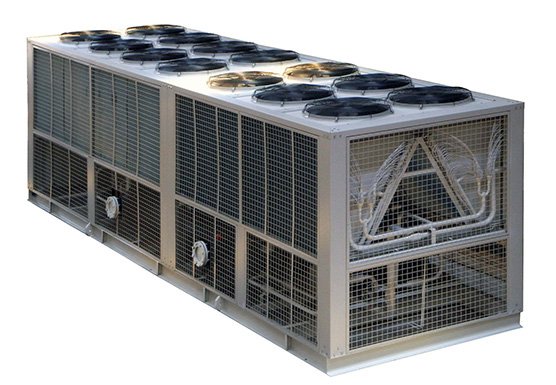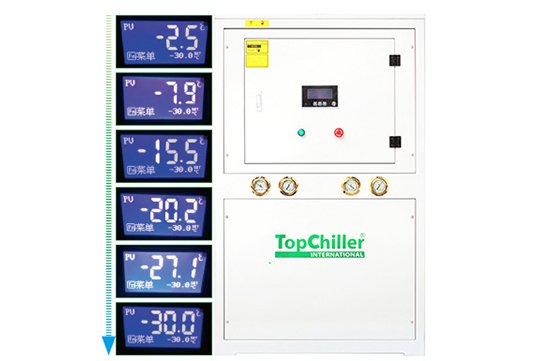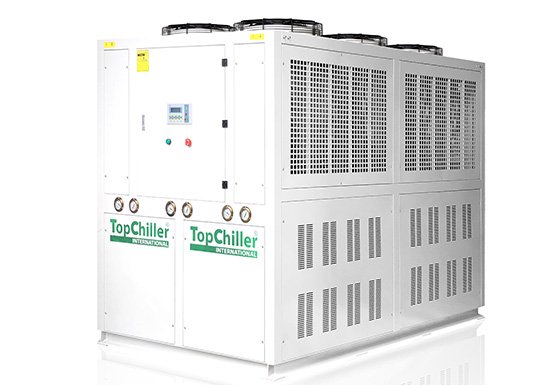TopChiller can design and manufacture all types of anodizing chillers for you
- Cooling capacity ranges up to 120 Ton
- Temperature control ranges 20°F to70°F
- Hermetic compressor from top brands
- Brazed plate evaporator& pump motor
- SS reservoir & powder coated cabinet
- Shell & tube/plate type heat exchanger
- Water tank and enforcing water pump
- Nonferrous construction & air inlet filters
Your Professional Anodizing Chiller Manufacturer and Supplier in China
Anodizing is an electrochemical process that coats the metals with an oxide layer making them more resistive to corrosion producing a large amount of heat.
Anodizing Chiller is a refrigeration-based cooling device that is used to release heat from anodizing machine, provide a cooling effect by using chilled water circulation.
TopChiller has been manufacturing and supplying a quality assured and steadfast working Anodizing Chiller to all over the world marketplace with prestigious designing for last twenty years in China.
TopChiller is offering a full line of various designs Anodizing Chiller that meet the needs of customers diligently. TopChiller is permanently getting updates about new technologies and market requirements to be prior in ranking by introducing a desirable Anodizing Chiller globally.
Anodizing Chiller made by TopChiller has primary components as scroll compressor, shell/plate type heat exchangers, condenser, reservoir, water tank, condenser valves, water pump, PLC-based temperature controller, hot gas bypass, solenoid valves, air inlet filters, evaporator, and power supply.
TopChiller brand Anodizing Chiller is superb steadfast and accurate in performance with a large number of benefits as given below:
- Anodizing Chiller is configured with water tank and water pump ensuring the steadfast heat exchange of machine with chiller by constant chilled water flow and pump pressure that enforces water to flow steadily.
- The energy-efficient condenser of Anodizing Chiller collects all heat coming from the attached machine with high heat capacity supported by condensed valves and then discharges heat efficiently from the unit either by chilled water or air circulation around the condenser.
- TopChiller designed Anodizing Chiller to stabilize the texture of anodizing metals during processing by regulating the temperature and pressure of the machine by PLC controller and self-testing sensors.
- Metals anodizing process is strengthened by Anodizing Chiller providing strength, corrosion resistance, and ornamental specifications to metal by using regulatory valves and solenoid valves that open to provide coolant when cooling required and closed after enough cooling.
Anodizing Chiller used in a diverse number of coating applications as given below:
Hard anodizing, commercial anodizing, impregnation, titanium anodizing, ornamental metalwork, metal coating, metal finishing, etc.
If you want to buy a world-class, peculiar temperature regulating, and reliable Anodizing Chiller for your application?
If you are deciding to build up your business by collaborating with a trustworthy company of China manufacturing steadfast Anodizing Chiller best applicable for your business?
You are directed on right track. TopChiller is the best collaborating and reliable company supporting our customers all time. Do visit or make a call to TopChiller technocrats and experts for getting a quote or a buying guide of an Anodizing Chiller.
TopChiller team has been trained and directed to lead the clients for best suited Anodizing Chiller selection at smart rates.
General Description:
Anodizing Chiller is a cooling processing unit intended to dispatch heat produced during anodizing or plating at industries. Temperature regulation during metal finishing is its core feature, ensuring the top quality of the final product.
In split designing, TopChiller has integrated the Anodizing Chiller with a scroll/screw compressor and evaporator for indoor installation. At the same time, the air-cooled condenser is installed outside. Refrigerant piping connects both sections. Except for the PID controller, control valve, expansion valves, and safety devices are also essential parts.
Chromic acid anodizing, plating, impregnation, powder coating, metal coating, furnace cooling, titanium anodizing, spot welding, etc., are applications of Anodizing Chiller requiring heat liberation.
If your application deals with the heat-generating process as anodizing and metal finishing etc. You need to install an Anodizing Chiller designed by the TopChiller brand.
TopChiller has been a leading manufacturer and supplier of Anodizing Chiller, serving its customers for the last twenty years by offering cooling solutions for plating industries.
So visit us today or contact the sales staff of TopChiller and confirm your order for either customized or standard Anodizing Chiller. All our cooling systems are credible and accredited with certification at reasonable costs.
Features and Advantages:
An Anodizing Chiller is fabricated with some fundamental features benefiting processing applications as given below:
- Heat is efficiently discarded out collected from anodizing process preventing metals texture and color damaging configured by air/water-cooled condensers.
- Metal plating equipment is protected from damage or disordering under regulated temperature control by the PID controller.
- Automatic control valves installation also assists in temperature maintenance of an anodizing electrolytic cell. Environment-friendly behavior due to sound refrigerant installation. Sturdy design with corrosion resistance configured by the construction of the unit with stainless steel material.
- While the coils of the condenser /evaporator are fabricated with rust-resistant copper metal. Installation of a cooling tower and water pump for a water cooling system assuring constant chilled water supply. Chilled water circulation assists heat collection and heat rejection from a plating process.
- The heat generated in the electrolytic cell during anodizing is detected above a predetermined value by thermal sensors. Regulated amount of coolant is sent to the system for heat discard featured by control valves of Anodizing Chiller.
- Data Sheet
- Image Gallery
- Main Parts
- Video
| Anodizing Chiller Technical Specifications | ||||||||||||||
| Items Model | AC-0.5A | AC-1A | AC-1.5A | AC-2A | AC-2.5A | AC-3A | AC-4A | AC-5A | AC-6A | AC-8AD | AC-10AD | AC-12AD | AC-15AD | |
| Cooling capacity | Kcal/h 50HZ/60HZ | 1419 | 2451 | 3182 | 4833 | 5848 | 7181 | 9288 | 11988 | 14534 | 18576 | 23994 | 29068 | 38270 |
| 1703 | 2941 | 3784 | 5800 | 7018 | 8617 | 11146 | 14386 | 17441 | 22291 | 28793 | 34882 | 45924 | ||
| KW 50HZ/60HZ | 1.65 | 2.85 | 3.7 | 5.62 | 6.8 | 8.35 | 10.8 | 13.94 | 16.9 | 21.6 | 27.9 | 33.8 | 44.5 | |
| 1.98 | 3.42 | 4.4 | 6.74 | 8.2 | 10.02 | 12.96 | 16.73 | 20.28 | 25.92 | 33.48 | 40.56 | 53.4 | ||
| Input power | KW | 0.88 | 1.35 | 2 | 2.25 | 2.66 | 3.27 | 4.07 | 5.75 | 6.45 | 8.25 | 11.5 | 12.9 | 17.45 |
| Max Current | A | 5.4 | 8.2 | 12 | 13.6 | 6.6 | 8.2 | 10.1 | 13.8 | 15.5 | 20 | 27.9 | 31.3 | 42.4 |
| Power source | 1PH~220V/3PH~220V/380V 50HZ/60HZ | 3PH~380V/415V/480V~50HZ/60HZ(3PH~200V/220V 50HZ/60HZ) | ||||||||||||
| Refrigerant | Type | R22/R407C/134a/404A/410A | ||||||||||||
| Control | Capillary / thermostatic expansion valve | |||||||||||||
| Compressor | Type | Hermetic Rotary | Hermetic scroll ( piston ) | |||||||||||
| Power(KW) | 0.45 | 0.89 | 1.3 | 1.73 | 2.1 | 2.7 | 3.5 | 4.55 | 5.25 | 3.5×2 | 4.55×2 | 5.25×2 | 7×2 | |
| Condenser | Type | Efficient finned copper tube with aluminum+low noise external rotor fan | ||||||||||||
| Air flow (m3/h) | 750 | 1000 | 1500 | 2000 | 2500 | 3000 | 4000 | 5000 | 6000 | 8000 | 10000 | 12000 | 15000 | |
| Air blower(KW) | 0.06 | 0.09 | 0.15 | 0.15 | 0.19 | 0.14×2 | 0.14×2 | 0.19×2 | 0.19×2 | 0.25×2 | 0.45×2 | 0.45×2 | 0.6×2 | |
| Evaporator | Type | SS Tank coil / shell and tube type / Plate type heat exchanger | ||||||||||||
| Chilled water (m3/h) | 0.28 | 0.49 | 0.64 | 0.97 | 1.12 | 1.44 | 1.86 | 2.4 | 2.91 | 3.71 | 4.8 | 5.81 | 7.65 | |
| 0.34 | 0.59 | 0.76 | 1.16 | 1.4 | 1.72 | 2.23 | 2.88 | 3.49 | 4.46 | 5.76 | 7 | 9.18 | ||
| Water tank(L) | 10.6 | 18.3 | 27 | 27 | 50 | 50 | 60 | 60 | 110 | 120 | 200 | 200 | 270 | |
| Inlet/outlet pipe (inch) i | 1/2″ | 1/2″ | 1/2″ | 1/2″ | 1″ | 1″ | 1″ | 1″ | 1″ | 1-1/2″ | 2″ | 2″ | 2″ | |
| Water pump | Power (kw) | 0.37 | 0.37 | 0.37 | 0.37 | 0.37 | 0.37 | 0.37 | 0.75 | 0.75 | 0.75 | 1.5 | 1.5 | 2.2 |
| Max lift(m) | 22 | 22 | 22 | 22 | 22 | 22 | 22 | 30 | 30 | 25 | 25 | 25 | 28 | |
| Max flow (m3) | 5.4 | 5.4 | 5.4 | 5.4 | 5.4 | 5.4 | 5.4 | 8.1 | 8.1 | 8.1 | 13.5 | 13.5 | 25.2 | |
| Safety protection | Compressor inner protection, over current protection, high/low pressure protection, over temperature protection, flow rate protection, phase sequence/phase missing protection, low level coolant protection, anti freezing protection, exhaust overheat protection | |||||||||||||
| Dimension | L(mm) | 550 | 550 | 600 | 600 | 720 | 980 | 980 | 1150 | 1150 | 1350 | 1500 | 1500 | 1860 |
| W(mm) | 350 | 450 | 500 | 500 | 550 | 520 | 520 | 560 | 560 | 680 | 760 | 760 | 850 | |
| H(mm) | 695 | 845 | 985 | 985 | 1350 | 1170 | 1170 | 1215 | 1215 | 1530 | 1660 | 1660 | 1900 | |
| Net weight(KG) | 45 | 62 | 85 | 95 | 125 | 152 | 175 | 185 | 215 | 283 | 345 | 382 | 580 | |
| Note: The above specifications are according to the following design conditions: 1, 12℃/7℃.Chilled water inlet/outlet temperature 12℃/7℃. 2, 33℃/38℃.Cooling air inlet/outlet temperature 33℃/38℃. We reserve the right to modify the specification without further notice. | ||||||||||||||
| Anodizing Chiller Technical Specifications | |||||||||||||
| Items Model | AC-15AT | AC-20AD | AC-20AF | AC-25AD | AC-25AF | AC-30AD | AC-30AT | AC-40AD | AC-40AF | AC-50AD | AC-50AF | AC-60AD | |
| Cooling capacity | Kcal/h 50HZ/60HZ | 36120 | 49966 | 47988 | 58480 | 58136 | 74734 | 74922 | 98040 | 99760 | 119024 | 116960 | 144996 |
| 43344 | 59959 | 57586 | 70176 | 69763 | 89681 | 89990 | 117648 | 119712 | 142829 | 140352 | 173995 | ||
| KW 50HZ/60HZ | 42 | 58.1 | 55.8 | 68 | 67.6 | 86.9 | 87.2 | 114 | 116 | 138.4 | 136 | 168.6 | |
| 50.4 | 69.72 | 66.96 | 81.6 | 81.12 | 104.28 | 104.64 | 136.8 | 139.2 | 166.08 | 163.2 | 202.3 | ||
| Input power | KW | 17.1 | 21.73 | 22 | 25.4 | 24.8 | 33.39 | 33.1 | 44.91 | 43.3 | 57.3 | 54 | 65 |
| Max Current | A | 43.2 | 52.7 | 53.3 | 63.7 | 61.3 | 81 | 80.2 | 109 | 106 | 135.5 | 128.5 | 135 |
| Power source | 3PH~380V/415V/480V~50HZ/60HZ(3PH~200V/220V 50HZ/60HZ) | ||||||||||||
| Refrigerant | Type | R22/R407C/134a/404A/410A | |||||||||||
| Control | Capillary / Thermostatic expansion valve | ||||||||||||
| Compressor | Type | Hermetic scroll ( piston ) | |||||||||||
| Power(KW) | 4.55×3 | 8.96×2 | 4.55×4 | 10.8×2 | 5.25×4 | 13.62×2 | 8.96×3 | 18.78×2 | 8.96×4 | 23.6×2 | 10.8×4 | 27.4×2 | |
| Condenser | Type | Efficient finned copper tube with aluminum+low noise external rotor fan | |||||||||||
| Air flow (m³/h) | 15000 | 20000 | 20000 | 25000 | 25000 | 30000 | 30000 | 40000 | 40000 | 50000 | 50000 | 60000 | |
| Air blower(KW) | 0.6×2 | 0.78×2 | 0.78×2 | 0.78×2 | 0.78×2 | 0.42×6 | 0.42×6 | 0.6×6 | 0.6×6 | 0.78×6 | 0.78×6 | 0.78×6 | |
| Evaporator | Type | SS Tank coil/ shell and tube type/Plate type heat exchanger | |||||||||||
| Chilled water (m³/h) | 7.22 | 10 | 9.6 | 11.69 | 11.62 | 14.94 | 15 | 19.6 | 19.95 | 23.8 | 23.4 | 29 | |
| 8.67 | 11.99 | 11.51 | 14.03 | 13.95 | 17.93 | 18 | 23.52 | 23.94 | 28.6 | 28.1 | 34.8 | ||
| Water tank(L) | 270 | 350 | 350 | 350 | 350 | 420 | 420 | 580 | 580 | 580 | 580 | 580 | |
| inlet/outlet pipe (inch) | 2″ | 2″ | 2″ | 2-1/2″ | 2-1/2″ | 2-1/2″ | 2-1/2″ | 3″ | 3″ | 3″ | 3″ | 3″ | |
| Water pump | Power(kw) | 2.2 | 2.2 | 2.2 | 2.2 | 2.2 | 4 | 4 | 4 | 4 | 5.5 | 5.5 | 5.5 |
| Max lift(m) | 28 | 28 | 28 | 28 | 28 | 30 | 30 | 30 | 30 | 32 | 32 | 32 | |
| Max flow (m³) | 25.2 | 25.2 | 25.2 | 25.2 | 25.2 | 36 | 36 | 36 | 36 | 40 | 40 | 40 | |
| Safety devices | Compressor inner protection, over current protection, high/low pressure protection, over temperature protection, flow rate protection, phase sequence/phase missing protection, low level coolant protection, anti freezing protection, exhaust overheat protection | ||||||||||||
| Dimension | L(mm) | 1860 | 2020 | 2020 | 2020 | 2020 | 2200 | 2200 | 2350 | 2350 | 2600 | 2600 | 2600 |
| W(mm) | 850 | 950 | 950 | 950 | 950 | 1150 | 1150 | 1350 | 1350 | 1500 | 1500 | 1500 | |
| H(mm) | 1900 | 2000 | 2000 | 2000 | 2000 | 1980 | 1980 | 2000 | 2000 | 2100 | 2100 | 2100 | |
| Net weight(KG) | 580 | 650 | 650 | 810 | 810 | 890 | 890 | 1112 | 1112 | 1320 | 1320 | 1320 | |
| Note: The above specifications are according to the following design conditions: 1, Chilled water inlet/outlet temperature 12℃/7℃. 2, Cooling air inlet/outlet temperature 33℃/38℃. We reserve the right to modify the specification without further notice. | |||||||||||||
Why TopChiller is Your Reliable Anodizing Chiller Manufacturer and Supplier In China?
Anodizing Chiller-An Ultimate FAQ Guide by TopChiller.
- What is Anodizing Chiller?
- What are the Main Components of an Anodizing Chiller?
- What are the Fundamental Features of Anodizing Chiller?
- What is the Working Principle of Anodizing Chiller?
- Why is an Anodizing Chiller Required for your Industry?
- What are the Prominent Applications of an Anodizing Chiller?
- What are the Excellent Advantages of an Anodizing Chiller for your Business?
- Which Optional Accessories are Available for an Anodizing Chiller?
- What are the Major Types of Anodizing Chiller?
- How is Air Cooled Anodizing Chiller Different from Water Cooled Anodizing Chiller?
- What is Split System for an Anodizing Chiller?
- What is the Cooling Capacity of an Anodizing Chiller?
- How Does Evaporator of an Anodizing Chiller Exchange Heat Between Refrigerant and Coolant?
- How Does an Expansion Valve Release Pressure from the Refrigerant of an Anodizing Chiller?
- Which Types of Condensers are Used for an Anodizing Chiller?
- Why is Anodizing Chiller Installed for Plating Process?
- How Does an Anodizing Chiller Regulate the Temperature of an Anodizing Process?
- How to Increase the Working Efficiency of your Anodizing Chiller?
- How to Size an Anodizing Chiller for your Applications?
- How to Troubleshoot your Anodizing Chiller?
What is Anodizing Chiller?
Anodizing Chiller is a uniquely designed cooling unit that efficiently discards heat from the processing system as anodizing and plating.
An anodizing is a metal finishing process in which the metal is coated with a metal layer instead of paint. Anodizing Chiller discards the heat which produces during this electrochemical process by water/air-cooled condensers.
Control valves and thermal sensors detect any alteration in temperature of anodizing process. It has environmentally friendly behavior due to ozone protecting refrigerant. It is renowned for easy installation and maintenance among a variety of applications.
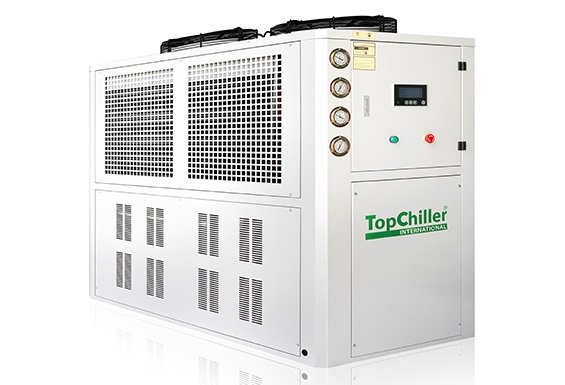
Anodizing Chiller Manufactured by TopChiller
What are the Main Components of an Anodizing Chiller?
An Anodizing Chiller efficiently discharges the heat produced during the anodizing process under its main integrated components as given below:
Condenser
An air-cooled condenser or water-cooled condenser condenses gas refrigerant into a liquid.
It is integrated with the unit for dissipating collected heat from the system. The heat is released either in water or air circulating over condenser coils.
Compressor
A scroll compressor is preferably installed as a fundamental component of the refrigeration cycle. It is used to increase refrigerant pressure by passing it from rotating scrolls.
One fixed scroll rotates over the other. It exerts a compression force over the refrigerant and increases its temperature and pressure.
Evaporator
A brazed plated evaporator/heat exchanger is used for exchanging heat between a low-pressure refrigerant and coolant.
The coolant absorbs heat from the anodizing process and transfers it to the refrigerant. The copper coils of the evaporator provide durability as well as working efficiency.
Expansion Valve
It is inserted between evaporator and condenser, mediating pressure relief of refrigerant coming from condenser. Pressure relief assists the refrigerant in absorbing heat with a large capacity.
Control Unit
PID-based microprocessor control helps regulate the temperature and other switches at normal setpoints for fluency in operation.
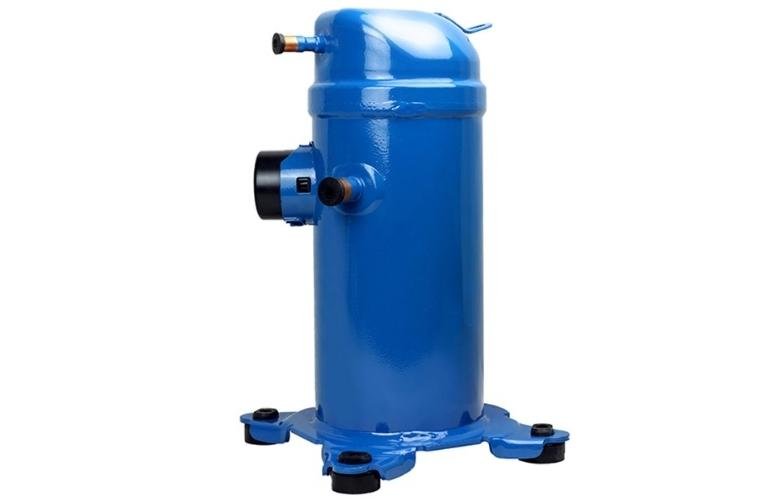
Anodizing Chiller Scroll Compressor
What are the Fundamental Features of Anodizing Chiller?
An Anodizing Chiller mediates a cooling effect by dissipating heat from the anodizing process. It is fabricated with an assorted number of fundamental features as given below:
- Water-cooled or air-cooled condenser integrated for discharging heat collected from the anodizing process.
- Reliable and energy-efficient semi-hermetic scroll compressor increasing refrigerant pressure.
- A nonferrous water circuit prevents the unit from rusting and cooling anodizing fluid.
- PID-based microprocessor controller regulating temperature and pressure of the unit for durability.
- High capacity insulated reservoir and insulated water pump.
- Environment-friendly refrigerant as R410A and R407C have no ozone reduction potential
- Brazed plate heat exchanger mediating heat exchange between the liquid refrigerant and chilled water.
- A split system ensures the safe outdoor installation of Anodizing Chiller even in an extreme environment.
- Refrigerant filters, solenoid valves, and water regulating valves of the condenser.
- Touch screen for maintaining and adjusting the overall operation.
Cooling capacity ranges from 1 Ton to 40 Ton with temperature control ranges from 0⁰F to 80⁰F.
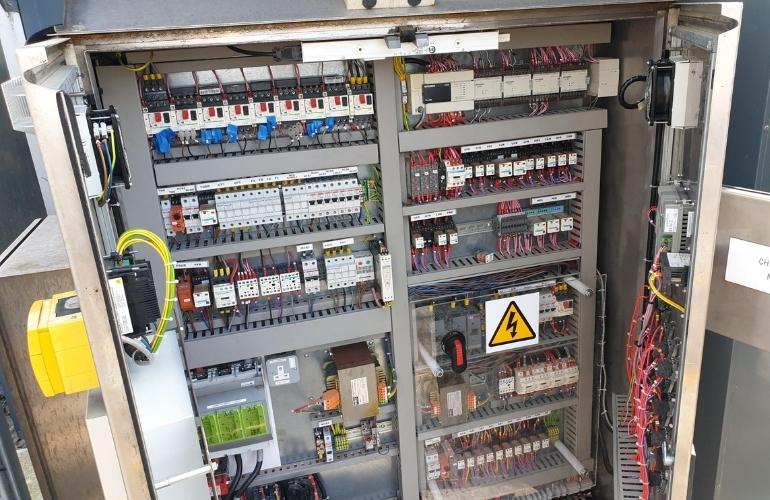
Anodizing Chiller Microprocessor Controller
What is the Working Principle of Anodizing Chiller?
The working principle of an Anodizing Chiller is to discard waste heat in the outside environment collected from anodizing process. By refrigerant compression and evaporation, heat is transferred to the external environment from the system.
Its main working steps are given below:
Step 1
The liquid refrigerant enters in brazed plate evaporator and circulates in its copper tubes. The chilled refrigerant with lower pressure ensures a high amount of heat absorption from the coolant.
The water coolant absorbs heat from an anodizing processing unit vessels and enters an evaporator with high heat content.
Step 2
The heat is efficiently exchanged between refrigerant and coolant due to turbulent flow. Ultimately, the liquid refrigerant changes its phase and enters into the compressor.
Step 3
When sucked by the compression suction valve, gas refrigerant with low pressure is further compressed by rotating scrolls of the compressor.
At reaching the discharge valve of the compressor, the refrigerant converts into high pressured and high-temperature refrigerant.
Step 4
High pressured gas refrigerant enters into the condenser. The air/water-cooled condenser dissipates all of the heat from the refrigerant and converts it into liquid refrigerant.
The chilled water coming from the cooling tower absorbs heat, or fresh air over condenser coils absorbs heat for final discharge.
Step 5
After that, liquid refrigerant leaves the condenser coils and passes out from the expansion valve. The valve expands the liquid refrigerant mitigating its pressure.
Step 6
Liquid refrigerant enters again into the evaporator to repeat the whole cycle. A thermal sensor is integrated with anodizing vessels.
When the temperature of anodizing goes above predetermined values, the control valves of Anodizing Chiller open automatically.
Step 7
The chilled coolant moves out from the evaporator and starts to flow around anodizing vessels until the temperature may not get normalized.
When the temperature reaches a set point, the valves of the chiller get closed to prevent anodizing material from extra cooling.
Why is an Anodizing Chiller Required for your Industry?
Most industries dealing with metals anodizing and plating processes require Anodizing Chiller to discharge heat produced during this process.
Need for Anodizing Chiller
- Anodizing of metal is a specified metal oxidation process in which the metal is coated with metal film instead of paint.
- The metal to be anodized is deposited as an anode in an electrolytic cell. Both electrodes are present in the electrolytic cell.
- The cathode is pleated with metal electrons. The electrons start depositing on the anode when an electric current is supplied through the anodizing rectifier. The thickness of the coating depends on anode exposure time.
- The greater the exposure time, the greater the thickness of the metal coating. A large amount of heat is produced during this process that should be eliminated.
- The extra heat can damage the anodizing process, coating layer, and aluminum oxidizing process. So a plating and anodizing industry always requires an Anodizing Chiller for discharging excess heat of the system.
- This water/air cooled chilling system is integrated with a processing system for temperature regulation by control valves and thermal sensors.
- Chilled coolant is supplied by continuously recycling refrigerant in the chiller to collect the waste amount of system heat.
What are the Prominent Applications of an Anodizing Chiller?
An Anodizing Chiller is renowned for its specified temperature regulation features and heat dissipation. Its prominent applications are given below:
- Laser Cooling
- Plating
- Anodizing
- Impregnation
- Powder Coating
- Metal Coating
- Titanium Anodizing
- Quench Cooling
- Commercial Anodizing
- Spot Welding
- Furnace Cooling
- Cooling for Induction furnace
- Chromic Acid Anodizing
- Die Casting
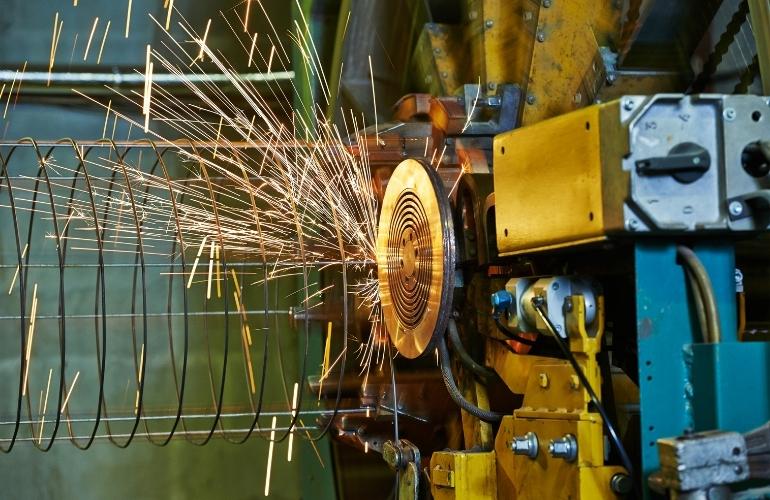
Applications of an Anodizing Chiller
What are the Excellent Advantages of an Anodizing Chiller for your Business?
An Anodizing Chiller offers excellent advantages to level up your business as given below:
Equipment Protection
Some industrial processes that dissipate heat as anodizing and plating processes, etc., are protected from heat damage. The chilling effect makes electrochemical cells and rectifiers durable by discarding all extra heat.
Durability
The water-cooled chilling system can easily install indoors in a harsh environment making it more reliable except for good quality material design increase service life.
Low Power Consumption
An energy-efficient compressor ensures low power consumption. Installation of economizer with compressor cause little power usage.
Environment-Friendly Behavior
Ozone protective refrigerant is installed that does not pollute the environment. Stainless steel designing and nonferrous water circuits make the unit environment-friendly and reliable.
Which Optional Accessories are Available for an Anodizing Chiller?
Different optional accessories are available to install or an Anodizing Chiller. These accessories assist in operation in different ways. Some of these are given below:
- Hot Gas by Pass Valve
- Closed Water Loop
- Remote Control Panel
- Chemical Pump System for Direct Cooling
- Flow Switches
- Logic Controllers
- Automatic Safety Device
What are the Major Types of Anodizing Chiller?
Based on the types of Condenser, an Anodizing Chiller is of two types:
Air Cooled Anodizing Chiller
An air-cooled one is fabricated with an air-cooled condenser for fresh air applications and a clean environment. For water-scarce areas, it is preferably installed.
Water Cooled Anodizing Chiller
It consists of a water-cooled condenser for applications in tropical areas or facing harsh environments.
Based on compressor type:
- Scrolled Type Chiller
- Screw Chiller
- Reciprocating Chiller
Based on Constructing Design, the Anodizing Chiller is available as:
- Split Chiller
- Modular Chiller
- Packaged Chiller
How is Air Cooled Anodizing Chiller Different from Water Cooled Anodizing Chiller?
Air Cooled Anodizing Chiller
It is integrated with all essential components of the refrigeration cycle. An air-cooled condenser is installed for condensation of the gaseous refrigerant. This unit is placed outside to reject the system’s heat by ambient air.
The gaseous refrigerant enters in air-cooled condenser after collecting heat from the anodizing process.
Ambient air absorbs all of its heat and discharges out into the environment. At the same time, the chilled refrigerant flows out to continue the refrigerant cycle.
Water Cooled Anodizing Chiller
It works on the same principle as an air-cooled chilling system. A water-cooled condenser is used instead of an air-cooled condenser for heat discharging. A cooling tower is also installed to provide a constant chilled water supply for the condenser.
Water flows over condenser tubes and absorbs refrigerant heat. After that, it flows back to the cooling tower to recover its chilling effect.
It can be installed feasibly indoors to come up with a harsh environment.

Air Cooled Anodizing Chiller
What is Split System for an Anodizing Chiller?
An Anodizing Chiller is constructed with different designs such as compact design and split system to meet the needs of various applications.
The split system consists of two sections. The components of the refrigeration cycle are divided into two parts.
Indoor Parts
The compressor and evaporator are installed indoors for heat refrigerant compression and heat exchange.
Outdoor Parts
While the air-cooled condenser is installed outside, it may get a direct air supply for heat discharge and ventilation.
All split system components are connected by pipes and a tubing system in which the refrigerant flows.
The split system cools the industrial process when both sections are plumbed together through refrigerant piping.
What is the Cooling Capacity of an Anodizing Chiller?
Cooling capacity is the capability of an Anodizing Chiller to discard a specific amount of heat from a system. It is available with different cooling capacity ranges from 1 Ton to 40 Ton with temperature control ranges 0⁰F to 80⁰F.
How Does Evaporator of an Anodizing Chiller Exchange Heat Between Refrigerant and Coolant?
An Anodizing Chiller is mediated for temperature regulation of anodizing/plating process by heat discharge. The evaporator is the core component of the refrigeration cycle, where heat is exchanged.
Working of Evaporator
The brazed plate heat exchanger is integrated into the unit. It consists of convoluted coils interspersed in plates of the evaporator. The liquid refrigerant flows in evaporator plates while the hot coolant circulates in evaporator tubing.
Both flows in a counter-current manner for heat exchange. Low pressured liquid refrigerant quickly absorbs the heat from the coolant and recovers its chilling effect.
On the other hand, anodizing vessels are connected with thermal sensors. When the temperature goes above specific values, it is being detected.
The automatic control valves open and allow the coolant to come out and circulate vessels. The coolant absorbs the heat of anodizing processing and circulates over until the temperature may not come at the required values.
After collecting waste heat from the system, the coolant moves back to the evaporator. At the same time, the control valves closed to prevent the system from extra cooling.
Coolant recovers its chilling effect in the evaporator for the next round. The gas refrigerant is condensed back by the condenser and enters again in the evaporator to repeat all the steps as above.
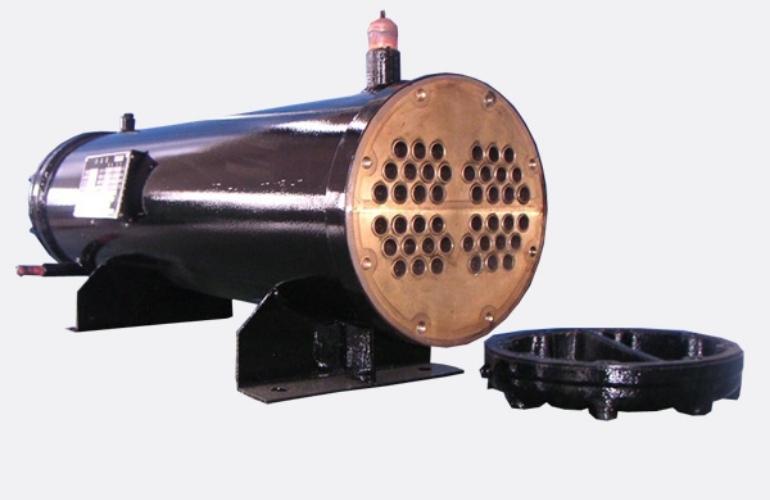
Anodizing Chiller Evaporator
How Does an Expansion Valve Release Pressure from the Refrigerant of an Anodizing Chiller?
The expansion valve is integrated between the condenser and heat exchanger of an Anodizing Chiller. The primary purpose of the expansion valve is to release pressure from the refrigerant.
After pressure release, the refrigerant gets cooled enough to absorb a high amount of heat from the coolant.
Inlet and Outlet Valves
The valve consists of inlets and outlet openings. A removable cartridge is adjusted with the valve’s inlet having an orifice. Its primary purpose is to control the refrigerant as per cooling required.
Through the inlet, a low pressured and low-temperature refrigerant enters. The refrigerant is expanded in the expansion valve, resulting in pressure discharge.
Ultimately a refrigerant with low pressure leaves the expansion valve through its outlet opening. Cartridge orifice mediated with sensory bulb gets closed to control the refrigerant flow.
For high cooling requirements, the refrigerant flow rate increases towards the evaporator. In this way expansion valve releases pressure from the refrigerant.
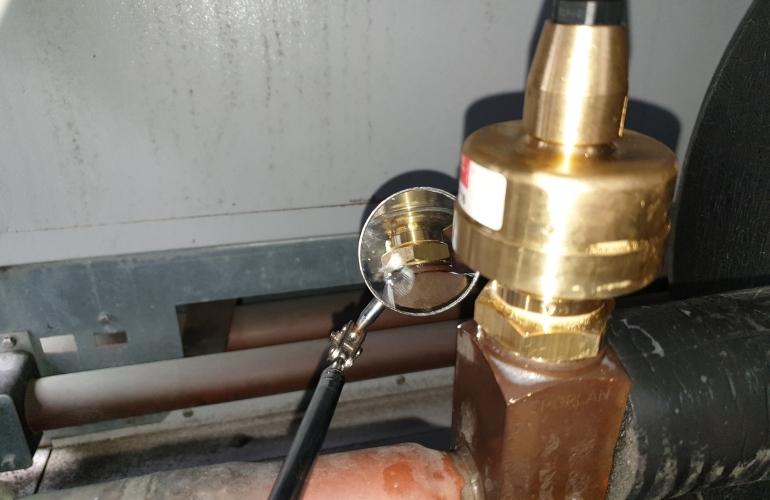
Anodizing Chiller Expansion Valve
Which Types of Condensers are Used for an Anodizing Chiller?
Two types of condensers are used for an Anodizing Chiller:
Air Cooled Condenser
The air-cooled condenser is selected for heat discharging when the outside environment has a low ambient temperature.
Air-cooled condensers have condenser coils made of copper metal. Fresh air spreads around condenser coils for heat exchange.
When the high pressured gas refrigerant flows in condenser coils, all of its heat is absorbed by ambient air.
As a result, hot air spreads around, and fresh air comes for continuous heat discarding from the refrigerant. Condenser fans spread ambient air over condenser coils.
There is no need for a cooling tower and water pump for heat rejection. The only air supply is enough for refrigerant condensation.
Water Cooled Condenser
If an anodizing or other metal coating process occurs at a site where the ambient temperature is very high.
The water-cooled condenser is installed to combat the harsh environment and efficient heat rejection.
This type of condenser has condenser coils and tubing for chilled water. A cooling tower is also integrated with it for continuous chilled water supply.
Through water piping, water reaches the sensor and absorbs heat from the refrigerant. Water rejects heat more efficiently as compared to air supply.
When water heats up, it is transferred back to the cooling tower. The cooling tower finally expels the heat in an outside environment and provides a chilled water supply for the next cycle.
Why is Anodizing Chiller Installed for Plating Process?
The plating process is also about the metal coating of different instruments that prevent rusting. The plating process is of different types depending upon the type of metal as:
- Zinc plating is mainly used for screws, nuts, and bolts
- Nickel plating either by hard nickel or soft nickel
- Chrome plating is used mainly for aerospace components and brake disks
Need for Installation
Frequently all of the above plating processes are performed electrolytically called electroplating. A large amount of heat is produced during the electroplating process. This heat can affect metal layers, as well as equipment.
To get prevention from heat, Anodizing Chiller is installed. It can discharge heat by its well-developed refrigeration cycle.
Waste heat is taken from the plating process and circulated through the refrigeration cycle. Ultimately heat is released out by the condenser. For this purpose, an Anodizing Chiller is installed.
How Does an Anodizing Chiller Regulate the Temperature of an Anodizing Process?
Anodizing is a highly reliable metal finishing process with excellent durability. Oxidized aluminum coating resists scratching. But during this process, a large amount of heat is produced that can be damaging.
Temperature Regulation
To compensate for this problem an Anodizing Chiller is being installed. It regulates the temperature of the anodizing process by collecting all of the waste heat from the system and dissipating it outside.
The thermal sensors are connected with vessels of anodizing equipment that detect the alterations in temperature. Control valves of chiller keep in contact with sensors.
The valve automatically opens when the plating/anodizing equipment temperature rises from the setpoint. Chilled coolant enters and circulates anodizing vessels for heat discharging.
When the temperature of the electrochemical process reaches on set point, the valves are automatically closed. Thus in this way, the temperature is regulated by an anodizing process.
How to Increase the Working Efficiency of your Anodizing Chiller?
An Anodizing Chiller assists processing industries in dissipating extra heat from the system, making the instrument durable. Its working efficiency can be increased for fluency in operation as:
Daily Maintenance
Make sure the maintenance and inspection of all components on a daily basis. If you find any fault, amend it on time for efficient performance.
Daily Cleaning
Clean the unit daily before the operation to remove all dust and debris. Also, ensure cleaning of condenser coils to prevent the water from contamination.
Installation of Safety Devices
Also, integrate safety devices for the unit’s regulated temperature, pressure, and voltage. It will prevent Anodizing Chiller from any hindrance in performance.
Calibration of Equipment
The equipment should be calibrated on time if many gauges or other components require calibration. Working efficiency increases when the equipment is with good calibration.
Water Treatment
Sometimes the water used for the condenser may get polluted with different impurities causing rust in the tubing. So go for water treatment and increase the overall working efficiency.
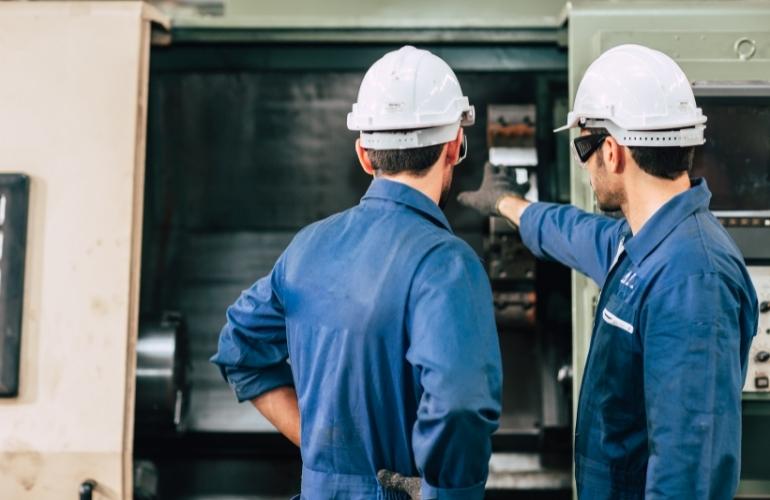
Anodizing Chiller Routine Maintenance
How to Size an Anodizing Chiller for your Applications?
An Anodizing Chiller is intended to dissipate additional heat produced during the anodizing process. It is available with different cooling capacities. You can select it by considering some essential critical points as given below:
Heat Load
Checking the heat load of your application is the crucial point to be considered. Measure the heating load of your application and then select the chiller that meets your cooling needs as:
- Check the current output of the rectifier either in amperes or voltage.
- For total BTU = Amps x Volts x 3.414
- For cooling capacity in tons, divide the total BTU with 12,000
- Cooling capacity inTons = BTU ÷ 12,000
Select according to the cooling capacity you may get from the above calculations.
Ambient Temperature
Select the Air Cooled Anodizing Chiller if the environment is dust-free, has low ambient temperature, and has water deficiency.
But in case of high ambient temperature and dusty environment, select the Water Cooled Anodizing Chiller.
How to Troubleshoot your Anodizing Chiller?
If there is a fault in any component, the overall working of Anodizing Chiller will be affected. So these faults and problems related to any part can be troubleshot in the following way:
Change in Refrigerant Level
If the coolant is with high cooling, then a sat point or low cooling may require. The problem must be due to the change in refrigerant level.
If coolant is not chilled correctly, check all refrigerant piping and tubing. Find the leaks and amend them to prevent refrigerants from further leaks.
For high chilling of coolant, check the expansion valves and orifice that control refrigerant flow and repair it or replace it with a new one.
Run Out the Unit
Sometimes the overall operation may get stopped. The problem can occur either in voltage change, pressure, or compressor malfunctioning.
Troubleshoot it by checking the circuit breaker and wiring. Adjust the voltage and pressure at the setpoint, replace the wiring and then turn on the circuit breaker for a startup.
Fluctuation in Flow rate
If the water flow rate is not according to heating load, the heat from the system would not be adequately dissipated.
The problem can be due to the accumulation of debris rusting in evaporator tubing or malfunctioning of the condenser. Repair the condenser unit with a new one and clean out the tubing for smooth water flow.
Color Variation During Anodizing
Sometimes change occurs in anodizing color. The problem may be due to the change in temperature and anodizing thickness.
It can be troubleshot by maintaining the temperature of the bath, discarding heat, and checking the control valves of the Anodizing Chiller.
Control valves should be at regular adjustment for coolant circulation around anodizing vessels.
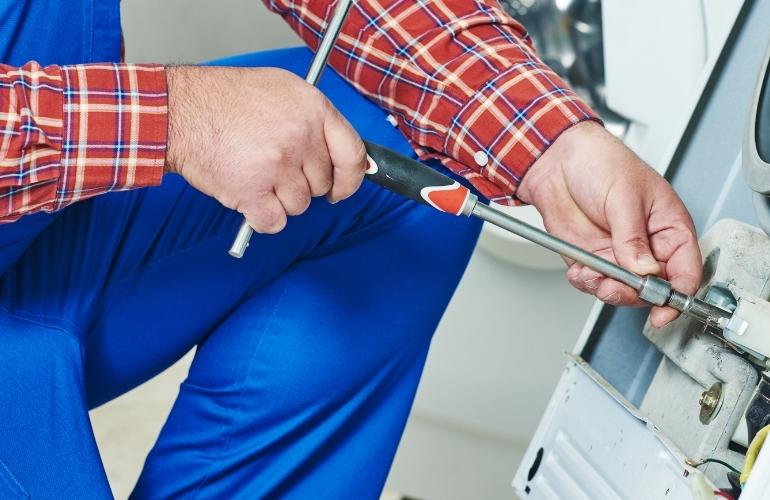
Anodizing Chiller Troubleshooting
